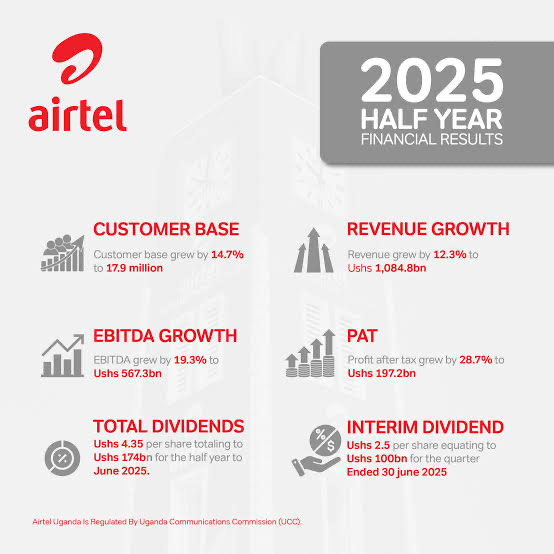Ugandans shift from voice to data as Airtel reports surge

Uganda’s telecom landscape is undergoing a seismic shift: mobile data, not voice calls, is now king. Airtel Uganda’s latest half-year results reveal just how quickly consumers are embracing the data-first economy, reshaping how operators do business and how millions of Ugandans connect.
For the six months ending June 30, 2025, Airtel reported a 30.4% surge in data revenue to Ushs 525.7 billion, nearly half of its total service revenues. Only a few years ago, airtime sales were the mainstay of telecom operators. Today, they are being eclipsed by demand for internet bundles, video streaming, and social media.
The numbers tell the story. Airtel’s active data subscribers jumped 25.9% to 7.5 million, with average monthly usage per customer climbing 22.6% to nearly 6GB. That appetite for bandwidth pushed overall network traffic up 57.4% in just six months, forcing Airtel to accelerate investment in its infrastructure: 176 new 4G sites, 1,793km of fresh fibre, and 150 additional 5G sites were added.
One of the most striking shifts is in network preference: 86.9% of all traffic now runs on 4G, compared to 80.4% a year earlier. For many Ugandans, it’s no longer enough to be online—the demand is for speed, reliability, and a seamless digital experience.
The Uganda Communications Commission (UCC) echoes this picture. Its Q2 2025 report shows 16.5 million mobile internet subscriptions, almost equal to the country’s 17.6 million smartphone users. At the same time, traditional voice airtime purchases continue to decline.
Social media dominates internet use. WhatsApp leads with 9.2 million Ugandan users, followed closely by TikTok at 8.8 million, YouTube at 6.1 million, and X (formerly Twitter) at 1.1 million. But it’s TikTok that is driving the heaviest consumption—accounting for 56% of all data traffic, compared with WhatsApp’s 24% and YouTube’s 13%.
Behind this shift is rising smartphone penetration. On Airtel’s network, it has reached 39.9%, aided by financing schemes like Airtel Badili and Mogo that make devices more affordable for ordinary Ugandans. As handsets become more accessible, data consumption continues to surge, expanding the digital economy far beyond urban centres.
The MyAirtel app also illustrates changing consumer habits. With 1.25 million monthly active users, it has become a one-stop digital service hub, reducing the need for physical visits to customer centres.
The growth of mobile internet isn’t limited to social media and entertainment. From small businesses that sell products via WhatsApp, to rural learners accessing digital classrooms, the impact is visible across society. The shift underscores how data is becoming central to economic activity, education, and social interaction.
If current trends hold, Airtel’s data business won’t just be a revenue stream, it could become the defining pillar of its business model. The broader industry faces the same reality: Ugandans are no longer buying airtime to talk; they are buying bundles to live, work, and socialize online.
As Uganda edges deeper into a data-first economy, the telecom sector may need to rethink its strategies from pricing models to infrastructure rollouts—to keep up with a population that is hungry not for minutes, but for megabytes.





